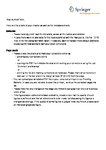Relative Pitch Perception and the Detection of Deviant Tone Patterns.
| dc.contributor.author | Denham, SL | en |
| dc.contributor.author | Coath, M | en |
| dc.contributor.author | Háden, GP | en |
| dc.contributor.author | Murray, F | en |
| dc.contributor.author | Winkler, I | en |
| dc.date.accessioned | 2017-01-06T06:40:44Z | |
| dc.date.available | 2017-01-06T06:40:44Z | |
| dc.date.issued | 2016 | en |
| dc.identifier.issn | 0065-2598 | en |
| dc.identifier.uri | http://hdl.handle.net/10026.1/8207 | |
| dc.description.abstract |
Most people are able to recognise familiar tunes even when played in a different key. It is assumed that this depends on a general capacity for relative pitch perception; the ability to recognise the pattern of inter-note intervals that characterises the tune. However, when healthy adults are required to detect rare deviant melodic patterns in a sequence of randomly transposed standard patterns they perform close to chance. Musically experienced participants perform better than naïve participants, but even they find the task difficult, despite the fact that musical education includes training in interval recognition.To understand the source of this difficulty we designed an experiment to explore the relative influence of the size of within-pattern intervals and between-pattern transpositions on detecting deviant melodic patterns. We found that task difficulty increases when patterns contain large intervals (5-7 semitones) rather than small intervals (1-3 semitones). While task difficulty increases substantially when transpositions are introduced, the effect of transposition size (large vs small) is weaker. Increasing the range of permissible intervals to be used also makes the task more difficult. Furthermore, providing an initial exact repetition followed by subsequent transpositions does not improve performance. Although musical training correlates with task performance, we find no evidence that violations to musical intervals important in Western music (i.e. the perfect fifth or fourth) are more easily detected. In summary, relative pitch perception does not appear to be conducive to simple explanations based exclusively on invariant physical ratios. | en |
| dc.format.extent | 409 - 417 | en |
| dc.language | eng | en |
| dc.language.iso | eng | en |
| dc.subject | Deviant detection | en |
| dc.subject | Musical intervals | en |
| dc.subject | Oddball paradigm | en |
| dc.subject | Pattern detection | en |
| dc.subject | Relative pitch perception | en |
| dc.subject | Translation-invariant perception | en |
| dc.subject | Adult | en |
| dc.subject | Aged | en |
| dc.subject | Female | en |
| dc.subject | Humans | en |
| dc.subject | Male | en |
| dc.subject | Middle Aged | en |
| dc.subject | Music | en |
| dc.subject | Pitch Perception | en |
| dc.subject | Task Performance and Analysis | en |
| dc.title | Relative Pitch Perception and the Detection of Deviant Tone Patterns. | en |
| dc.type | Journal Article | |
| plymouth.author-url | https://www.ncbi.nlm.nih.gov/pubmed/27080682 | en |
| plymouth.volume | 894 | en |
| plymouth.publication-status | Published | en |
| plymouth.journal | Adv Exp Med Biol | en |
| dc.identifier.doi | 10.1007/978-3-319-25474-6_43 | en |
| plymouth.organisational-group | /Plymouth | |
| plymouth.organisational-group | /Plymouth/PS - Doctoral College | |
| plymouth.organisational-group | /Plymouth/REF 2021 Researchers by UoA | |
| plymouth.organisational-group | /Plymouth/REF 2021 Researchers by UoA/UoA04 Psychology, Psychiatry and Neuroscience | |
| plymouth.organisational-group | /Plymouth/Research Groups | |
| plymouth.organisational-group | /Plymouth/Research Groups/Centre for Brain, Cognition and Behaviour (CBCB) | |
| plymouth.organisational-group | /Plymouth/Research Groups/Centre for Brain, Cognition and Behaviour (CBCB)/Brain | |
| plymouth.organisational-group | /Plymouth/Users by role | |
| dc.publisher.place | United States | en |
| dc.rights.embargoperiod | Not known | en |
| rioxxterms.versionofrecord | 10.1007/978-3-319-25474-6_43 | en |
| rioxxterms.licenseref.uri | http://www.rioxx.net/licenses/all-rights-reserved | en |
| rioxxterms.type | Journal Article/Review | en |


